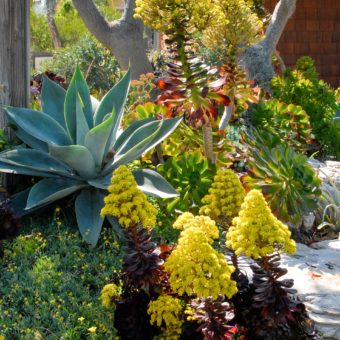Many agave species and cultivars tend to grow “pups.” These are small new plants that grow off of the “mother” plant and are attached underground. Pups are often directly at the base of the mother plant, but can also grow some distance away, depending on the species of agave. These pups can be removed with a shovel at any time to preserve the appearance of the mother plant and to prevent overcrowding. Pups can often be either planted elsewhere in the garden, or rooted into pots for later planting or to give to someone else.
Agaves are “monocarpic,” which means that after years of growing, they only flower one time, and then the main plant dies. Often pups remain, providing new plants to replant in the same place if desired. The length of time from planting an agave until it flowers varies and is related to multiple factors including growing conditions and plant species.
Over time, some of the lower leaves of agaves naturally die and dry out as new leaves grow. This is normal, and dry leaves can be carefully pulled off or cut with a small sharp saw or serrated blade. Be careful not to remove too many leaves, or you might lose the beautiful natural form of the agave and end up with something looking more like a pineapple!
The most important factor in keeping agaves as a low maintenance plant is to understand how large mature agaves of each species and cultivars will be (listed above), and provide for that much growing space in planting plans. Often people plant agaves which at maturity will be far too large for the space they are put in, but look nice when they are newly planted and young. If they do not have enough space to grow, many agaves become hazardous near paths and sidewalks when their spines reach into places people are walking. This leads to them having to be cut back on a regular basis, creating an ugly plant that is no longer low maintenance and is hazardous. Do things right: plant in the right place with enough space and enjoy a beautiful low-maintenance plant!
References



